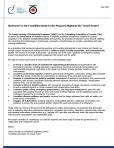The Ontario Society of Professional Engineers (OSPE) and the Tunnelling Association of Canada (TAC) recognize the Government of Ontario’s interest in exploring ambitious infrastructure solutions to address congestion in the Greater Toronto Area (GTA). Among these, the proposed 50-kilometre tunnel beneath Highway 401, stretching from Mississauga to Scarborough, represents a transformative yet complex undertaking with wider-reaching implications.
As organizations that represent engineering expertise and tunnelling professionals across Ontario and Canada, we strongly support infrastructure development that is evidence-based, fiscally responsible, and environmentally sound. The success of any large-scale project, particularly one of this scale, depends on transparent analysis, prudent risk assessment, and meaningful engagement with experts and the public.
We urge the Ontario government to ensure that the current feasibility study:
1. Is led by a Canadian team of experienced engineering professionals and organizations with international expertise, including specialists in geotechnical, structural, mechanical, transportation, and environmental engineering, particularly in the design and delivery of large-diameter tunnels in urban environments.
2. Considers construction logistics, related to geotechnical investigation, construction working sites, disruption to traffic flow during construction for material flow and discharge of the excavated tunnel spoil.
3. Provides a comprehensive, publicly available assessment of geological, hydrological, and environmental conditions, with scenario comparisons including elevated highways, HOV lanes, Intelligent Transportation Systems (ITS), and rail alternatives.
4. Includes a full cost-benefit analysis, with transparent accounting of capital, operational, and lifecycle costs, as well as potential impacts on carbon emissions and transportation mode shifts.
5. Evaluates public safety, emergency preparedness, and long-term maintenance, given the risks associated with tunneling beneath an active and heavily trafficked highway, and the additional hazards and challenges presented by an emergency in a tunnel.
6. Considers climate resilience and equity, ensuring that the design addresses flood risks, air quality, and access across communities.
7. Engages all stakeholders, including engineers, municipalities, planners, Indigenous communities, and residents, to ensure that any proposed solution reflects the needs and priorities of all Ontarians.
Finally, while we commend the government’s willingness to explore bold solutions, we emphasize that alternatives such as evaluating alternative underground alignments, expanding rail corridors, integrating regional transit networks, and revisiting underutilized infrastructure (e.g., Highway 407) may offer cost-effective, lower-risk options that align with long-term transportation and sustainability goals.
We remain committed to contributing our collective expertise and stand ready to advise the government in a collaborative and transparent manner.
Signed,
Ontario Society of Professional Engineers (OSPE)
Tunnelling Association of Canada (TAC)


